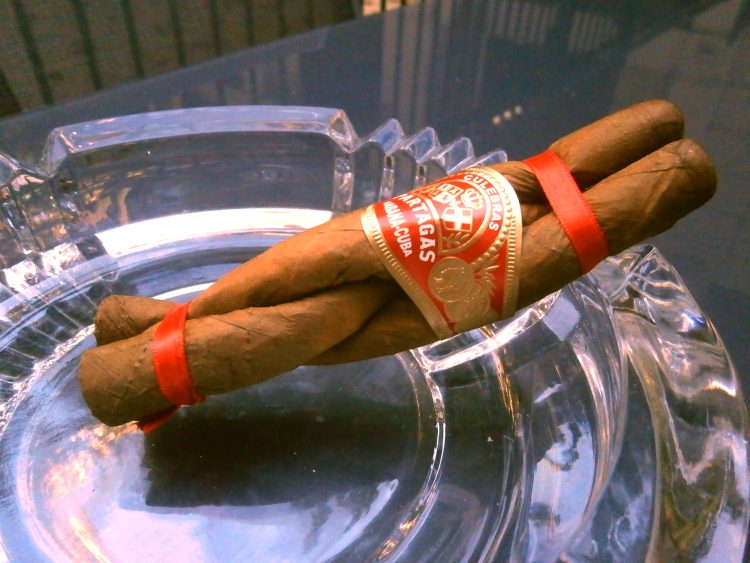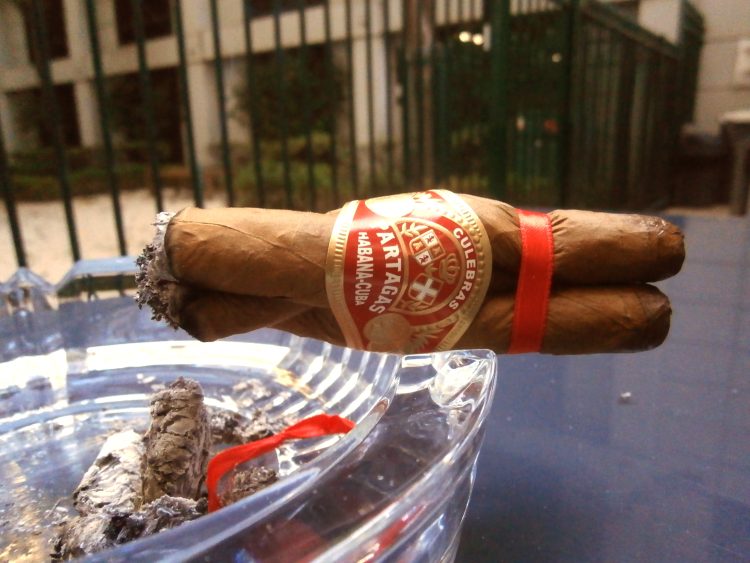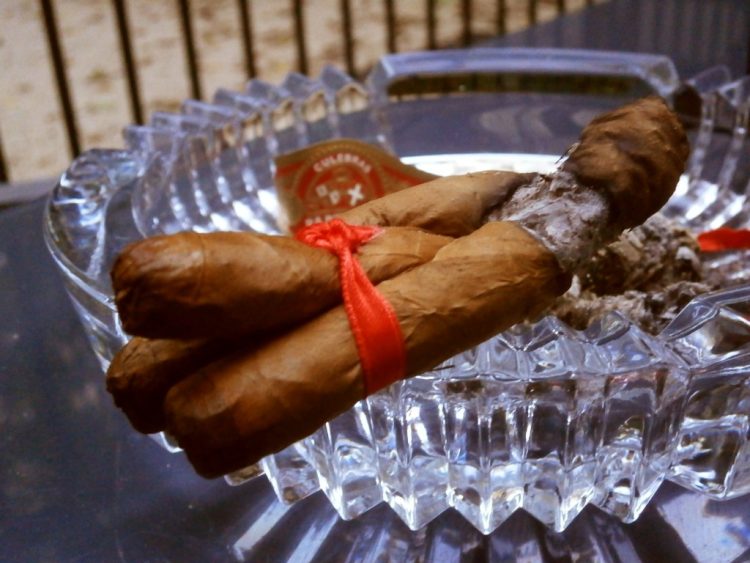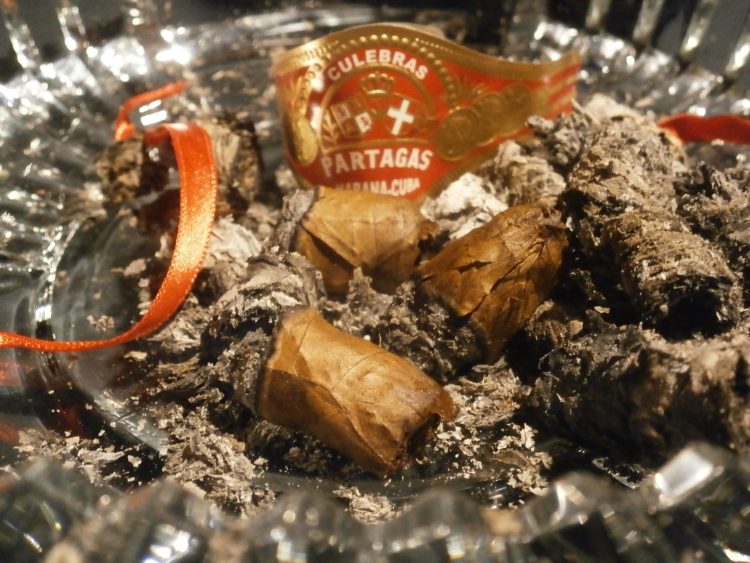The Nicaraguan cigar industry, plagued as it is by small independent producers scrabbling to distinguish themselves from each other, produces a lot of novelty cigars; a quick perusal of any US based online cigar store will reveal cigars as long as your arm, cigars with two-tone barber-pole striped wrappers, cigars shaped like onions, square cigars, and a never ending quest for thicker and thicker ring gauges and darker and darker wrappers. Cuba, on the other hand, with its virtual monopoly of the premium cigar market everywhere outside of the States, doesn’t feel the same drive, and stays more or less entirely within the same basic shapes and sizes it has been producing for five centuries. As always there is one exception: the Partagás Culebras.
Once manufactured by a few different brands, the only surviving Cuban Culebras is the Partagás one (and that has been announced as discontinued more than once, although stock seems to keep appearing). It’s an odd duck, with three heads and three feet, and a twisted mess of tobacco in-between them.
I try to open it with a cutter, but can’t manoeuvre the thing in properly, and so wind up using my fingernail. Lighting is actually easier than you would expect; the feet aren’t quite level, so a narrow, precise jet-flame and a steady hand can light each one individually without blacking the side of another. I wouldn’t recommend trying to light this one with a match. Straight away I discover that it’s impossible to toke from all three heads at once – you can’t create a seal with your lips and end up just drawing in outside air. It is easy enough to draw on each one individually, however, and I quickly fall into a rhythm of puffing from one and rotating the cigar. This would probably be a good choice for the smoker who puffs too often and causes his cigar to burn hot; the staggered inhalations keep each coal relatively un-stoked. One head has a slightly looser draw than the other two, but all fall well within the bounds of acceptability.
The cigar is very mild with light earthy notes. Deeper in there is leather and coffee. It’s a basic, nice quality light Partagás profile – not as rich as a D4 or any of the banner cigars. Maybe the start of a Lusitania.
The fire is still a good millimetre above the first ribbon when I notice it (the ribbon) beginning to melt. I untie it as quick as I can, but it leaves a thin line of melted red plastic on the cigar. As it burns off I avoid inhaling, stoking the fire by alternately exhaling through the cigar and blowing directly onto the coal. Here’s a piece of trivia for all you aspiring aficionados out there to file away: Partagás Culebra ribbons are 100% polyester.
As the cigar tightens in on itself the three coals become one, and each puff flares the entire coal. I slow my toke speed to match. I have been finding myself spending a lot of time following the paths of the cigar up, trying to figure out which end leads to which, but now that the cigar is tight and it’s all one coal, it doesn’t really matter. The flavour is still very light, mild tobacco, although the earthy tones have graduated to more of a grassy, woody note. It doesn’t offer all that much, but it is a very pleasant, no nonsense sort of cigar.
I’m about two thirds of the way through my second beer, a White Rabbit Dark Ale, when my manservant Davidé polishes off his fourth and proposes a run to the bottle-shop for some hard liquor. In a moment of weakness I toss him the keys to my cabinet upstairs and tell him to get himself a bottle of Jack Daniels. He returns ten minutes later with the most expensive scotch in the place, a Glenfiddich 125th Anniversary Edition that I bought duty free a couple of years back, having deemed the Daniels, along with various Johnny Walkers, bourbons, and the odd Islay Single Malt, unworthy of his distinguished palette. He promptly pours himself a double.
The beer, for what it’s worth, is excellent. I don’t have a palette for the stuff, but Davidé tells me it’s extremely chocolaty, and I tend to agree. It complements the cigar very nicely.
Although I have been puffing on the triumvirate equally, the looser drawing pathway in the cigar is (fairly predictably) burning a little quicker than the other two, and as the cigar starts to tighten for a second time it begins to become a problem. I remove the main band and push the miscreant up so that the coal is level with the others. The unfortunate side effect here is that one head is now impossible to puff on. Hopefully the proximity of the others will keep it going but, if not, I suppose I can always relight. Overall the cigar is excellent, burning very cool and presenting not the slightest hint of tar, even at this late stage. The notes are lightly herbal with a faintly earthy finish. I retrohale and get a creamy note for a minute that is far above this cigar’s pay-grade.
I finish off the beer and pour myself a small dram of the Glenfiddich as Davidé helps himself to another full tumbler. The swine is shitfaced, and slumped in his chair he gurgles with wet mirth as I make snide comments about the forty dollar’s worth of whiskey he has just inhaled. It’s an odd duck, the 125th Anniversary, with a shocking amount of peat for the Lairds of smooth Speyside. It’s not quite the tar pit of a Laphroaig or Lagavaulin, but there is a distinct iodine note in there. I’ve never been a fan of smoky whiskies with cigars as I find that they tend to bring out the worst from the leaf, exacerbating the bitterness of the tar. Fortunately, in the Partagás Culebras there’s no tar to exacerbate.
Eventually I reach the inevitable point and have to untie the final ribbon, causing the cigar fall apart. Disassembled, it resembles three petite coronas, two in the final inch and one few centimetres longer. I smoke them down to three separate nubs, puffing in rotation.
In the end this is a very easy going, no-nonsense sort of a cigar. Were it a straight parejo it would no doubt be a sleeper favourite amongst Partagás fans. As it is it is a fun, perfectly smokable cigar that deserves more than novelty status. In fact, I really feel that should be more Culebras in the world: if you’re in the business of commissioning regional edition cigars, I strongly recommend you order up a paper-wrapped Fonseca Culebras, or at least a Ramón Allones one, because I certainly enjoyed this more than a PSD4.



